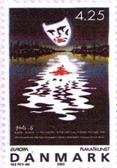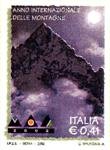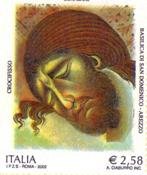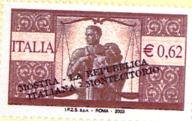International
Comparison of World Stamps Designs
By Prof. Chae-Suk Lim*
and Dr. Yang-Taek Lim**
Abstract
A
stamp is an artistic article using high-tech paper and printing technologies
and designs to express historical themes and modern sentiments of a country.
GPSPC (Government Postage Stamp Printers Conference) established in 1986 to
encourage government stamp producers and exchange information on management and
technology holds, every year, a world stamp exhibition in which its 22 members
participate. The current paper compares Korean stamps with foreign ones by
focusing on the design themes expressed in the stamps exhibited on the 2004
10th GPSPC World Stamp Exhibition in Poland. It is a general trend for a stamp
of a country to have become a national culture product, particularly in the era
of telecommunications due to the development of IT.
I.
Introduction: History of Stamps in Korea
There have recently been many discussions
and arguments over whether to change the designs and specifications of Korean
bank notes and whether to issue large denomination bills. The most important
requirement of a bank note is that it should incorporate a combination of
counterfeit prevention technologies and designs and have aspects of an
international currency.[1] In contrast, a stamp is an artistic
article that uses paper technologies and printing technologies to express
themes and topics reflecting values of an era. For mass, a stamp is a means for
paying for communication with others, while a stamp collector thinks it as a
cultural asset that he/she wants to keep through life.
Retrospectively,
it has been 121 years since Korea issued its first stamp. However, Korean
stamps were issued by foreigners before 1946. First five kinds of
'mun'-denominated stamp were designed by Hong Young-Sik in 1884. But they were
printed by the Japanese Ministry of Finance that used letterpress printing to
issue stamp. Issuance of the 'mun'-denominated stamps were ceased because of
the 1884 Kapshin Coup d'Etat. In 1893, a US mint company (Andrew B. Graham Bank
Notes) issued four kinds of Korean regular stamps by using offset printing. In
1903, the Printing Bureau of France 13 kinds of Korean regular stamps by using
letterpress printing. The stamps issued by Korea were only 14 kinds of regular stamps
printed between 1900 and 1901 by the Printing Bureau of the Ministry of
Agriculture and Commerce of Daehan Empire and the commemorative stamp of the
40th anniversary of the accession of the Emperor Gojong. In 1905, Japanese
imperialist government seized all post offices in Korea and banned use of
Korean stamps after forced occupation of Korea in 1910. Although Korea was
liberated from Japanese imperialist rule in 1945, Korean stamps were printed by
Japan because of poor printing technologies of Korea.
The
commemorative stamp of the first anniversary of liberation in 1946 was the
first that was issued by Korea. After that, Josun Book Co. Ltd., Seoul Whale
Culture Press, and Dongyang Press issued stamps by using imposition printing,
letterpress printing and offset printing between 1947 and 1952. The first
Korean stamps issued by KOMSCO (Korea Minting and Security Printing
Corporation) were a regular stamp (Tae Guk-Ki) and the commemorative stamp of
the second anniversary of the inauguration of the 2nd President of Korea.
After
then, KOMSCO has made efforts to develop technologies in order to improve the
quality of Korean stamps to world-class level. KOMSCO imported Klimsch camera
for prepress from Germany and used negative film of stamp on Misomex exposure
system from Sweden, reducing spacing error down below 1/100 mm. Also, plate for
offset printing developed from decalcomania printing plate through albumen zinc
plate and albumen aluminum plate through PS plate. Glued paper took the place
of glued paper since August 1964, and stamp paper with colored fiber embedded
was used. This made KOMSCO achieve remarkable improvement in stamp printing
technologies. In 1968, KOMSCO imported Goebel Gravure press from Germany and
learned gravure stamp printing technology from German engineers. This enabled
KOMSCO to print the first gravure printing based regular stamp called
Tae-guk-ki. In 1986, KOMSCO bought electronic color separator, which shortened
the time for stamp printing and provided remarkable improvement in color
rendering and quality. In 1999, KOMSCO bought a new-model gravure six-color
system to raise the quality of Korean stamps to a world-first level. It should
be noted that KOMSCO printed a special stamp smelling violet for the first time
in the world on February 25, 2000, exhibited it at the 2002 Seoul World Stamp
Exhibition of GPSPC and won the prize of best stamp. This 'aromatic stamp'
triggered the issuance of British coffee-smelling stamp and Swedish
chocolate-smelling and rose-smelling stamps. Recently, 'customized stamps' have
been issued. KOMSCO started to mark the full name of stamp printer on stamps on
January 16, 2005. The stamp commemorating the nature of Mara Island was the
first one that the full name of stamp printer was printed on. This is to
improve the responsibility and pride of printers in order to raise stamp
printing quality.
II. World Stamp Exhibition
GPSPC (Government Postage Stamp Printers
Conference) was established in 1986 in order to encourage government stamp
producers to exchange information on management and technology. Every year, the
Conference holds a world stamp exhibition in which its 22 members participate.
This chapter will compare Korean stamps and foreign ones by focusing on the
themes expressed in the stamps exhibited on the 10th GPSPC World Stamp
Exhibition.
1.
Korean Stamps
KOMSCO succeeded in holding the 9th
conference of GPSPC in 2002 and the stamps exhibited by the corporation won the
grand prize in three sectors: 1) offset-printed stamp (special stamp for a week
for hobby of stamp collection : Buljong Pavilion of Mt. Kumgang painted by Jong
Son (1676-1759), a painter in the era of Josun), 2) unique stamp (special stamp
for endangered and protected animals and plants : fragrant stamp) and 3)
combination stamp (special stamp showing world-heritage listed remains : a
panoramic view of Changduk Palace).
|
[Offset-printed
stamp] |
[Unique stamp] |
[Combination stamp] |
|
Issued
on: Aug 2, 2002 |
Issued
on: Feb 25, 2000 |
Issued on: Dec 10, 2001 |
|
Printed
in: 5 colors with lithography |
Printed
in: 5 colors with gravure
printing |
Printed in: 6 colors with offset
printing and 1 color with intaglio printing |
At the World Stamp Exhibition of the 10th
conference of GPSPC (held in Poland), KOMSCO's stamps won the Regularity Award
given to the winner of the highest score in total in the areas of offset,
intaglio, gravure, combination, multiple and unique stamps. In 2005, KOMSCO's
stamps won the grand prize of printing at the World Stamp Exhibition of GPSPC
held in China. This made world pay attention to the excellence of Korea's stamp
printing technology. This was additional evidence of prominent stamp-printing
technology of Korea, which was proved by Muga-jeonggwang-dae Darani Sutra,
which is the oldest wood block in the world, and Jikji Simche Yojol, which is
the oldest metal-print in the world.
○ A commemorative stamp of the 'Week of
Women' (July 1 to July 7) has been offset-printed every year. This stamp is
printed in order to encourage development of women and promote a social
campaign to increase public attention to improved sexual equality.
○ Unique stamps have been intaglio-printed
in order to communicate the taste and wisdom of traditional living by showing
household utensils, like light fixture, used by our ancestors.
○ A joint stamp showing cultural remains of
Korea and Vietnam, i.e. Dabo Tower (Korea) and One Post Tower (Vietnam) was
gravure-printed in order to commemorate the 10th anniversary of establishment
of diplomatic relation between Korea and Vietnam (December 22, 2002).
○ Combination stamps were designed that
expressed dolmens in Ganghwa, Hwasun and Gochang. These dolmens are important
resources for researching the funeral and rituals of pre-history period.
○ Multiple stamps contain designs of
cymbidium kanran, gastrodia elata, pogonia japonica and cephalanthera falcata.
Unique stamps are designed on the basis of the cartoon 'Fools' Village
Schoolhouse' drawn by a cartoonist Yoon Sung-Wun who has drawn, written and
published joy cartoons and history cartoons for children.
|
[Commemorative stamp of the Week of Women] |
[Unique stamps showing traditional
living and culture] |
|
|
|
|
Printed on: Jul 1, 2002 |
Printed on: Jul 1, 2002 |
|
Offset printing |
Intaglio printing |
|
Image area : 22mm X 32mm |
Image area : 35mm X 35mm |
|
Sheet composition: 4X5 |
Sheet composition: 4X4 (roll) |
|
Punching angle: 13 degrees |
Punching angle: 13 degrees |
|
[Commemorative
stamp of the 10th anniversary
of the establishment of diplomatic
relations between Korea and Vietnam] |
[Unique
stamps showing world-heritage listed
remains] |
|
|
|
|
Printed on: Dec 21, 2002 |
Printed on: Dec 9, 2003 |
|
Gravure printing |
Combination printing |
|
Image area : 27mm X 37mm |
Image area : 52mm X 24mm; 52mm X 36mm |
|
Sheet composition: 4X4 |
Sheet composition: 2X5 (combined) |
|
Punching angle: 13 degrees |
Punching angle: 13 degrees |
|
[Stamps of the series of Korean orchid] |
[Unique stamps of cartoon] |
|
|
|
|
Printed on: Nov 12, 2002 |
Printed
on: May 4 , 2002 |
|
Paired printing |
Intaglio
printing |
|
Image area : 27mm X 37mm |
Image
area : 36mm X 26mm |
|
Sheet composition: 4X5 (vertical paired
printing of four stamps |
Sheet
composition: 5X4 |
|
Punching angle: 13 degrees |
Punching
angle: 13 degrees |
2. Foreign Stamps
As listed in Appendix of the current paper, many beautiful stamps were
presented at the World Stamp Exhibition of the 10th (2004)
conference of GPSPC held in Poland. These stamps are classified by the
participant country as follows :
Algeria : Escargots
Austria : 250 Years Zoological Gardens Schönbrunn, Gustav Klimt
Judith I,
"Soundcloud
over Limz"(a music festival), Introduction of the Euro, and
Soundcloud
over Linz.
Belgium : Belgium Castles, Red Cross, Common Issue with Russia to commemorate
150 years of
relationship between Mechelen and St. Peterburg,
George Simenon,
Drive, and 150 years High Education in Antwerp.
Brazil : Sivam
Project (Surveillance System of Amazonia), and
Mercosur
Issue (Recycling-Handicrafts).
China : Suzhou Gardens (The Garden of the Fisherman), Art of
Books,
The Royal
Carriage (Souvenir Sheet), Tibetan Antelope, and
Chinese
Lengends (The Story of Butterfly Lovers).
Czech Republic : Vlaho Bukovac (1855~1922)’s
Divan, Antonim Slavicek (1870~
1910)’s Autumn
Veltrusy (1896), and Animal Breeding-Aquarium Fish.
Denmark : Diana’s Garden, The Danish Literary Greenland
Expedition,
Royal
Jelling (Harald’s Stone), and Landscapes.
Germany : Benefit Stamps for Sports 2002, “Fools 5” (EUROPA),
The 2002
Olympic Winter Games in Salt Lake City, and
100th
Anniversary of Deutsches Museum(a gear wheel).
Italy : Italian Design (Haute Couture), Philatelic Exhibition “The
Italian Republic”,
Arnolfo di
Cambio (Sick Man at the Fountain), Chamber of Deputies, and
“International
Year of the Mountains”.
Poland : Children Games and Amusements, Historic Steam Engines,
Europe,
7th
Visit of John Paul II to Poland, and 160th Anniversary of Birth of
Maria
Konopnicka.
France : Saint-Valentine, French Gardens, Basilica of
Notre-Dame, The Dancers,
and Best
Wishes.
Spain : World Heritage, 2003 European Year of People with
Disabilities, Stained Glass Windows of Santa Maria Cathedral in the Town of
Vitoria,
“The Music”, Castle of Calatorao, Pope John
Paul II, and Camilo Jóse Cela.
Sweden : The St. Bridget Jubilee, The East Indiaman, “Pope John
Paul II”, and
“Harvest
Time”.
Ukraine : “Maniavskyi Cell”, “Carpathian Cell”, “Yavoriv
National Natural Park”, and
Owls of
Ukraine.
III.
Conclusion
As described above, a stamp is an
artistic article using high-tech paper and printing technologies and designs to
express historical themes and modern sentiments of a country. In this 21st
century, competitive culture products are required. A stamp is a national
culture product.
Now, KOMSCO has world-level paper and
printing technologies and design competitiveness. If these technologies are
fused with the themes and designs of stamps publicizing Korean culture and
traditions, Korean stamps can play roles of artistic articles and culture
products improving the image of Korea. For example, we can communicate the
taste and humor of Korean nation if we make Korean stamps into artistic articles
and culture products by expressing following themes on the stamps:
○ Korean nation blossomed most advanced
culture, which is evidenced by the fact that Korean nation developed world-best
printing technology which is a core source of human civilization.
○ As is shown by the fact that Korean
nation enjoyed the renaissance of science and art in the era of King Sejong in
the 15th century, Korean nation loved art and science and put them into
practical use.
○ Korean nation had spirit of scholar and
refined taste, and regarded morality and virtue as basic principles of life and
politics.
○ As shown by the idea of Dan-gun, Korean
nation was humanitarian one that thought highly of human life (for instance,
Hu-Joon who was a famous doctor in the era of Josun, professor Hwang Woo-Sok
and his study on embryonic stem cell, etc.)
○ In recognition of recent world focus on
the possibility of crisis in Korea, it is necessary to communicate that Korean
people have taken sides with peace.
○ It is necessary to show that lost history
of Goguryo is alive in Korea, by using the remains of Goguryo like the monument
of the Great King Gwangaeto.
○ Dokdo, which is natural monument no. 336,
is surely belonged to Korean territory.
○ Korea is the mecca of globalization
opening up IT era.
<
References >
Lim,
Chae-Suk and Lim, Yang-Taek (2004), "Banknote Designs and Counterfeit
Prevention Technologies : OECD Members Countries", International
Regional Research, Vol. 8 Issue 2, pp. 423~450.
<
Appendix >
Algeria

Austria




Belgium





Brazil


China





Czech



Denmark




France






Germany





Italy




Poland








* Assistant Professor, Department of Industrial
Design, Multimedia College, Seoul Digital University
(Chaesuklim@empal.com).
** Professor,
Department of Economics and Finance, College of Economics and Finance, Hanyang
University (limyt@hanyang.ac.kr)
[1] See Lim, Yang-Taek (2004).
[ BWW Society Home Page ]
© 2005 The BWW Society/The Institute for the Advancement of Positive Global Solutions








